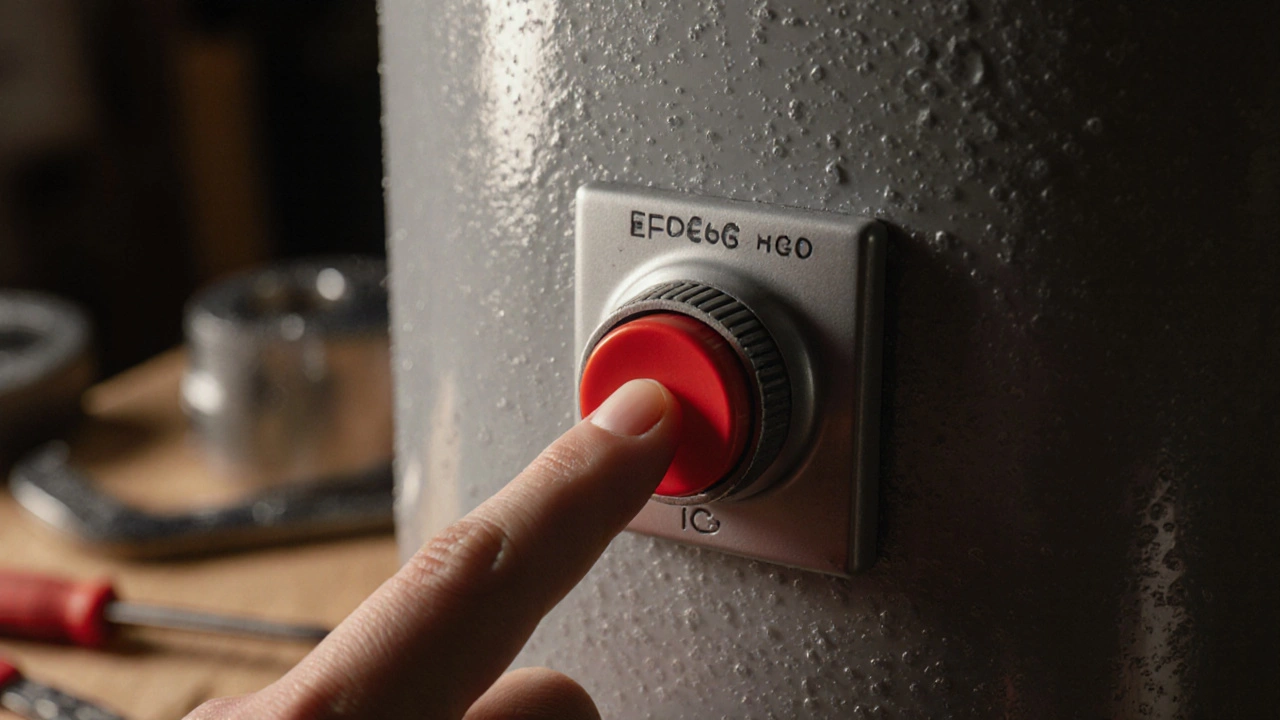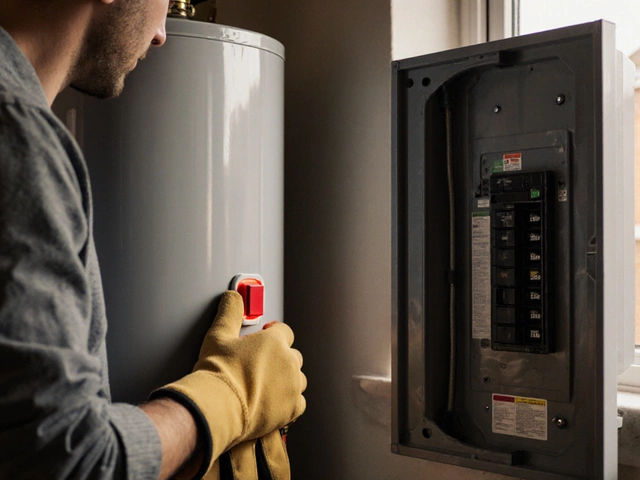When your water heater stops producing hot water, the first thing many people try is pressing the reset button. It’s simple, it’s quick, and it’s often the fix. But how long should you actually hold it down? The answer isn’t what you might think - and getting it wrong could mean wasted time, or worse, damage to your system.
What the Reset Button Actually Does
The reset button on your water heater isn’t a power switch. It’s a safety device called a high-limit switch. It trips when the water inside gets too hot - usually because of a malfunctioning thermostat or a wiring issue. When it trips, it cuts power to the heating elements to prevent overheating, scalding, or even a tank rupture.
This button is usually red and located on the thermostat panel. On electric water heaters, you’ll find it on the upper thermostat, sometimes behind a removable metal cover. Gas water heaters don’t have this button - their safety systems work differently.
How Long to Press the Reset Button
You don’t need to hold it for five seconds. You don’t need to hold it for ten. You don’t even need to press it at all.
Here’s the truth: the reset button doesn’t need to be pressed at all - it just needs to be reset. That means you simply push it in until you hear a soft click. That’s it. One firm press. That’s all it takes to reset the circuit.
If you press and hold it like you’re trying to reboot a computer, you’re not helping. You’re just wasting time. The switch is mechanical, not electronic. It doesn’t need a reset sequence. It’s either tripped or not. Pushing it in resets it. Holding it does nothing extra.
Why the Reset Button Trips in the First Place
Resetting the button might bring your hot water back - temporarily. But if it trips again within a few days, you’re not fixing the problem. You’re just covering it up.
Here are the most common reasons the reset button trips:
- A faulty upper thermostat - the most common cause. If it’s stuck on, it keeps heating past the safe limit.
- Mineral buildup on the heating element - this causes uneven heating, leading to overheating in one spot.
- Loose or corroded wiring - bad connections can cause power surges that trigger the safety switch.
- A failing high-limit switch itself - yes, the reset button can go bad and trip for no good reason.
If you’ve reset the button and it works again, but then trips a second time, you’re not dealing with a one-off glitch. You’re dealing with a real problem that needs fixing.

What to Do After Resetting
After you press the reset button, wait 30 to 60 minutes. Electric water heaters take time to reheat. Don’t rush to check the water right away. If you turn on the tap too soon and get cold water, you might assume the reset didn’t work - when really, it just hasn’t had time.
Once you’ve waited, test the hot water at the nearest tap. If it’s hot and stays hot, you’re good - for now. But keep an eye on it. If the water starts getting lukewarm again, or the reset button trips again, don’t keep resetting it.
Repeated resets are a red flag. It’s like repeatedly restarting a car that won’t start because the fuel pump is broken. You’re not fixing the problem. You’re just delaying the inevitable.
When to Call a Professional
If the reset button trips more than once, or if you notice any of these signs, it’s time to call a qualified technician:
- Water that smells like rotten eggs - this means sulfur bacteria are growing in the tank.
- Visible rust or leaks around the tank - corrosion means the tank is failing.
- Strange noises - popping, rumbling, or banging usually mean heavy sediment buildup.
- The reset button won’t stay in - if it pops back out immediately, the internal mechanism is broken.
Most homeowners try to fix this themselves to save money. But if the thermostat or heating element is faulty, replacing it requires working with live electrical wires. One mistake, and you could get shocked - or start a fire.
In the UK, water heaters are often installed with strict electrical safety standards. A certified electrician or heating engineer will know how to test the thermostat, check the elements, and verify the wiring. They’ll also test the pressure relief valve - another critical safety feature many people forget about.

Preventing Future Trips
You can reduce the chances of your reset button tripping again with a few simple habits:
- Flush your tank every 6 to 12 months - this removes sediment that causes overheating.
- Set your thermostat to 120°F (49°C) - this is hot enough for most homes and reduces strain on the system.
- Don’t turn the thermostat up higher than needed - more heat doesn’t mean faster recovery. It just means more wear.
- Install a water softener if you live in a hard water area - Bristol has moderately hard water, and mineral buildup is a real issue here.
These steps don’t just prevent reset button trips. They extend the life of your water heater by years. Most electric water heaters last 8 to 12 years. With proper care, you can easily push that to 15.
What Not to Do
There are a few dangerous myths floating around:
- Don’t tape the reset button down. This disables the safety feature. If the thermostat fails, your tank could overheat and explode.
- Don’t replace the reset button with a regular switch. It’s not a power button. It’s a lifesaver.
- Don’t ignore repeated trips. Every time it resets, you’re risking damage to the heating elements, thermostat, or even the tank lining.
These aren’t just bad ideas - they’re risks to your home and family.
Final Tip: Check the Age of Your Water Heater
If your water heater is older than 10 years, and the reset button keeps tripping, it’s probably time to replace it. Repairing an aging unit often costs more than replacing it - especially when you factor in labour, parts, and the risk of a sudden failure.
Modern water heaters are more efficient, safer, and come with better warranties. If you’re in Bristol and your heater is over a decade old, think about upgrading. You’ll save money on energy bills, avoid emergency repairs, and never have to worry about the reset button again.
How long should I press the reset button on my water heater?
You only need to press it once - just push it in until you hear a click. Holding it down does nothing. The reset button is a mechanical safety switch, not a power button. One firm press is all it takes.
Why does my water heater reset button keep tripping?
If it trips more than once, it’s not a coincidence. The most common causes are a faulty thermostat, mineral buildup on the heating element, loose wiring, or a failing reset switch itself. Repeated trips mean the system is overheating - and that’s a sign of a deeper problem that needs professional attention.
Can I fix a tripping water heater myself?
You can reset the button safely, and you can flush the tank yourself. But if the problem keeps coming back, don’t try to replace the thermostat or heating elements unless you’re qualified. Electric water heaters use 240 volts - one wrong move can lead to electrocution or fire. Call a certified electrician or heating engineer.
Is it safe to keep resetting the button if the water goes cold again?
No. Resetting the button repeatedly is like ignoring a car’s check engine light. You’re not fixing the problem - you’re hiding it. Each trip puts stress on the system and increases the risk of tank failure or electrical damage. If it trips twice, get it checked.
How often should I flush my water heater?
Flush it every 6 to 12 months, especially if you live in an area with hard water like Bristol. Sediment buildup is the #1 cause of overheating and premature failure. Flushing takes about 30 minutes and can extend your heater’s life by years.



